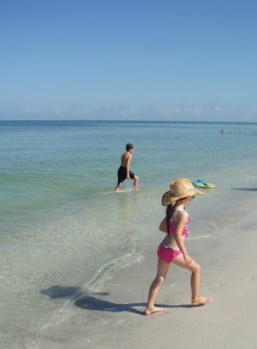 Family Travel Files Ezine Family Vacations Resource Family Travel Files Ezine Family Vacations Resource |
Using Sunscreen Is a Must for Everyone Including Kids. Most parents routinely use sunscreen on their children but are the the types that they using really safe? Experts offer timely practical advice. 
As summer days at the beach approach the reviewing the current thinking about sunscreen may be is helpful. Just trusting that all products are equal is not the best plan when it comes to protecting little ones. The best words of advice come from a post which first appeared at The Mom in Me, MD blog . The author (Emma) who is a mom and physician sums up the points very well. Read on if sunscreen matters to you.
Here’s the scoop. Emma writes: I recently had to make a sunscreen switch for my own daughter after reviewing the American Academy of Pediatrics and the FDA’s updated guidelines and recommendations. Since I was in the dark on this topic, I thought I would share four important points that every mom should know.
1. Ditch the Oxybenzone. When a friend asked me my opinion about oxybenzone in children’s sunscreen, I gave her a blank stare. I hadn’t really heard all that much about it, and I assumed that the concerns were simply social media hype. Trying not to be too skeptical, I told her that I would look into it. To my surprise, there does seem to be some legitimate concern regarding oxybenzone, although some organizations such as the American Academy of Dermatology do still think that it is safe to use in children. (The CDC and the Environmental Working Group).  This product which is found in many infant and children sunscreens can act like a hormone, potentially influencing our developing children’s endocrine systems. Although long-term studies have not yet been done to determine the extent of the harm, the American Academy of Pediatrics is recommending that parents avoid this ingredient when purchasing sunscreen. In a society where precocious puberty (puberty at a young age) is becoming a more common issue, I decided it was probably a good idea to not take a chance. I’ve opted for an oxybenzone free sunscreen. On a side note, if you are going to be out in the sun and your only option for sunscreen contains oxybenzone, go ahead and use it. Infrequent use is probably not going to have an effect on your child’s hormone levels, but we do know that sunburns in childhood definitely predispose them to skin cancer later in life.
2. Aerosolized Children’s Sunscreen May be a “No, No”. Many of the large sunscreen companies have made our lives as moms much easier! They have created an aerosolized sunscreen revolution. It’s fast, it’s much less messy, and it goes on more easily. Bad news is…we aren’t exactly sure what it might be doing in our children’s lungs. The whole point of an aerosolized sunscreen is that it sprays through the air onto the skin. Our children are inevitably breathing in some of this spray. Because the aerosolized sunscreens contain nano particles (incredibly tiny particles), when breathed in they are able to travel much further into the lungs. There is concern in the medical community that these nano particles might cause local irritation in the lung tissue or result in increased absorption with unknown long-term effects. If you have to use an aerosolized spray, first spray it onto your hand (away from your child) and then apply it to your child’s skin directly. 
3. Broad Coverage Update. The FDA has changed its regulations on how companies are allowed to promote their sunscreens. They can only advertise “Broad Coverage” if they provide both UVA (ultraviolet ray A) and UVB (ultraviolet ray B) protection. You want to make sure that you are choosing a sunscreen that has both of these. This is the only way to prevent not only sunburns, but also long term risk for skin cancers. In addition to broad coverage, make sure that you look for an SPF of at least 15 to 30 (50 would be great if you have the option). Anything higher than 50 doesn’t really have any additional protection as far as we can tell. So, if it says SPF 70 but no broad coverage, don’t buy it!
4. Put it on Before You Hit the Beach and then Keep Reapplying. Sunscreen needs a little time (15-30 minutes) to absorb in order to be effective. Don’t wait until you are already in the sun to put it on your kids. Apply it before you leave the house so that they will be protected from the harmful UV rays the entire time they are in the sun. Remember to keep reapplying it as well. Once and done is not going to work. Most sunscreens need to be reapplied after two hours. However, if your child is swimming or sweating, you should reapply it sooner.
Check out the AAP Sun Safety Guideline Information Sheet for Parents for more information on sun protection. Remember, protecting your child’s skin from burns today will protect him/her from skin cancer later in life. It really is that important.
The Mom in Me, MD is a blog dedicated to educating women about relevant and sensitive health topics; empowering them in their own journeys through infertility, pregnancy, motherhood, and illness; and inspiring them to advocate for their own health and that of their children.
Content courtesy of Emma at the Mom in Me, MD. Introduction cmments by Nancy Nelson-Duac, Curator of the Good Stuff for the Family Travel files. Images from Family Travel Files. Copyright updated 2018.
|